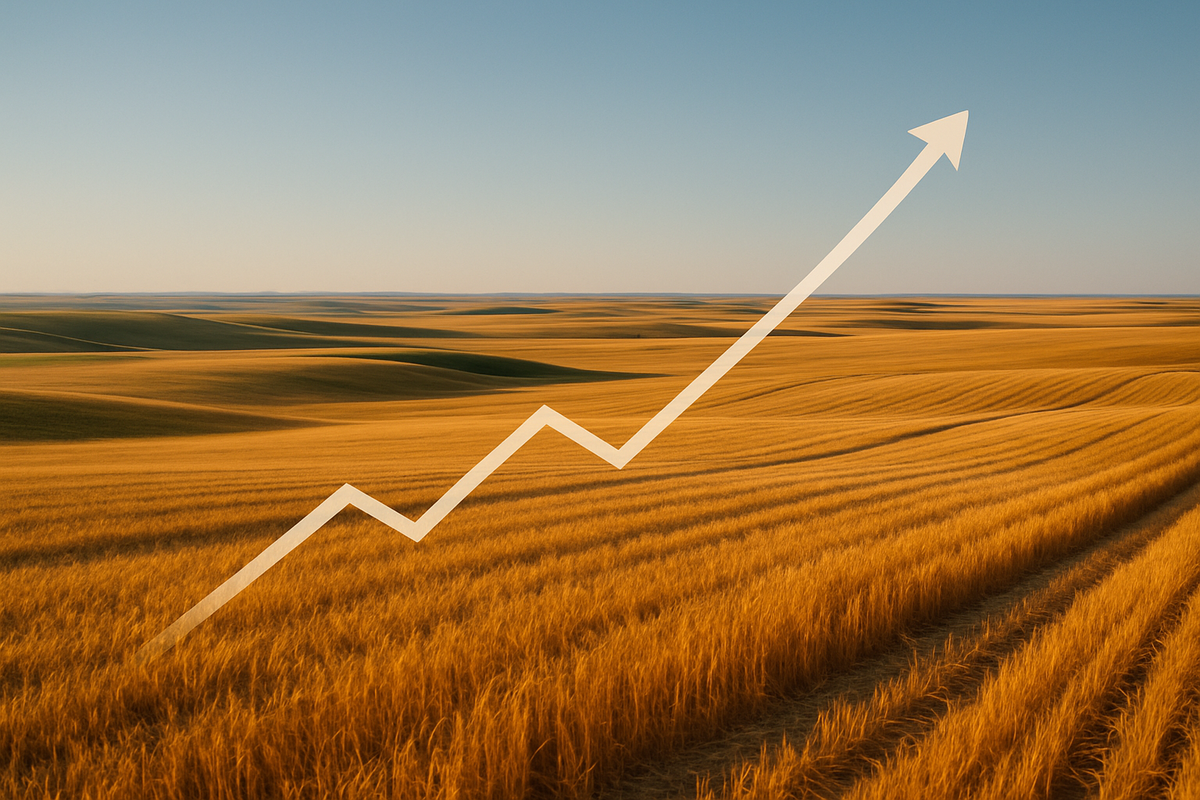Prairie Farmland Values Soar Amidst Commodity Price Dip: A Paradoxical Market Reshaping Agriculture

Calgary, AB – October 9, 2025 – In a surprising turn for the agricultural sector, Prairie farmland values have continued their steady appreciation through 2024 and the first half of 2025, defying a period of softening agricultural commodity prices. This counter-intuitive trend highlights a deeper confidence in agricultural land as a long-term asset, even as farmers grapple with tighter margins in the short term. The phenomenon suggests a significant shift in market dynamics, with profound implications for food production, rural economies, and investment strategies across Canada's vast agricultural heartland.
The immediate implication of this divergence is a growing affordability crisis for many farmers. Farmland is currently at its least affordable point in at least 40 years when measured against farm revenues and interest rates, posing substantial barriers for new entrants and challenging expansion plans for existing operations. This situation is fostering an environment of caution, yet the underlying demand for land remains robust, driven by factors beyond immediate crop profitability.
Unpacking the Persistent Rise of Prairie Farmland
The relentless climb in Prairie farmland values is a testament to the enduring appeal and perceived stability of agricultural land. In 2024, Canadian cultivated farmland values increased by an average of 9.3%, a slight deceleration from previous years but still a substantial gain. This upward trajectory continued into 2025, with an average national increase of 6.0% in the first half of the year, pushing the 12-month growth from July 2024 to June 2025 to 10.4%.
Leading this appreciation are the Prairie provinces. Manitoba saw an impressive 11.2% growth in farmland values in the first half of 2025, with Alberta following at 6.6% and Saskatchewan matching the national average at 6.0%. Over the full year from July 2024 to June 2025, Manitoba farmland values surged over 14%, Saskatchewan increased by 12%, and Alberta recorded just over 10% growth. This strong performance occurred despite a projected 6% decline in grain and oilseed receipts for 2025, following a 1.6% drop in 2024.
Several key factors underpin this paradoxical appreciation. A consistently limited supply of available farmland, coupled with strong long-term confidence in the agricultural sector, creates a competitive market where demand outstrips supply. Healthy farm balance sheets, bolstered by record crop years in 2022 and 2023, have provided many farmers with the financial capacity to invest in land expansion. Furthermore, an easing trend in interest rates, alongside the view of farmland as a stable, inflation-hedging asset with low correlation to traditional financial markets, continues to attract both farmers and non-farming investors. Increased productivity through advances in crop science and capital investment also contributes to the perceived long-term value of productive land.
Winners and Losers in a Shifting Landscape
The dichotomy of rising land values and falling commodity prices creates a clear divide among public companies operating within the agricultural ecosystem. While some stand to gain from the appreciation of underlying assets, others face significant headwinds as farmer profitability is squeezed.
Potential Losers: Agricultural equipment manufacturers, seed, and fertilizer companies are likely to bear the brunt of this trend. With lower commodity prices eroding farm incomes, farmers are becoming more cautious with capital expenditures, delaying purchases of new machinery and potentially cutting back on variable input costs. This has led to weak demand and, in some cases, production cuts. Companies like Deere & Company (NYSE: DE), AGCO Corporation (NYSE: AGCO), and CNH Industrial (NYSE: CNHI) are highly susceptible to reduced farmer spending on new equipment. Similarly, seed and fertilizer giants such as Nutrien Ltd. (TSX: NTR), The Mosaic Company (NYSE: MOS), and CF Industries Holdings, Inc. (NYSE: CF) could see reduced sales volumes, although rising fertilizer prices in 2025 may partially offset volume declines. Corteva Agriscience (NYSE: CTVA), a major player in seeds and crop protection, has already faced downgrades due to the challenging agricultural macro-environment and thinner farmer margins. Agricultural lenders, despite benefiting from enhanced collateral due to rising land values, face risks from deteriorating credit conditions and decreasing loan repayment rates as farm incomes decline. Federal Agricultural Mortgage Corporation (Farmer Mac) (NYSE: AGM) has seen its stock plunge, reflecting broader challenges in the agricultural finance sector.
Potential Winners: Land investment firms, whose business model directly benefits from the increasing value of agricultural land, are well-positioned to thrive. These entities view farmland as a secure, long-term investment offering capital appreciation and wealth preservation. Companies like Gladstone Land Corporation (NASDAQ: LAND) and Farmland Partners Inc. (NYSE: FPI), both publicly traded Real Estate Investment Trusts (REITs) that acquire and lease farmland, stand to benefit directly from the appreciation of their core assets. Other diversified landholders, such as Adecoagro S.A. (NYSE: AGRO) and Tejon Ranch Co. (NYSE: TRC), could also see their balance sheets strengthened by rising land values, even if their operational farming profits are impacted by commodity price fluctuations.
Wider Significance: Consolidation, Investment, and Policy Challenges
The sustained appreciation of Prairie farmland values against a backdrop of lower commodity prices signals a fundamental transformation in the agricultural landscape, extending beyond mere market fluctuations. This trend is deeply embedded within broader industry shifts, including accelerating consolidation, increasing financialization of farmland, and critical policy implications.
The Canadian agricultural sector is experiencing significant consolidation, with larger operations expanding their footprint and market share. This is driven by economies of scale, the capital-intensive nature of modern farming, and the need for continuous investment in technology to enhance productivity. The high cost of farmland exacerbates this, creating formidable barriers for smaller, family-owned farms and new entrants, thus accelerating the trend towards fewer, larger agricultural enterprises.
Farmland has also solidified its position as an attractive asset class for a diverse range of investors, including private equity and institutional funds. Its appeal stems from its tangible nature, perceived inflation resistance, and low correlation with traditional financial markets, making it a safe haven during economic uncertainty. Canadian farmland values have demonstrated remarkable long-term appreciation, increasing over 300% in the last 20 years, further fueling investor demand. This influx of non-farming capital, while providing liquidity, intensifies competition for land and contributes to price increases, potentially detaching land values from immediate agricultural profitability.
These trends have significant ripple effects on rural communities. The increasing cost of land can lead to an erosion of direct land ownership by farmers, with more land being held by investors and leased back to operators. This can make farmers and their communities more financially precarious and contribute to the "hollowing out" of rural areas as farm families are displaced, impacting local services and social fabric. Concerns about "rural disintegration" and threats to food sovereignty, as articulated by groups like the National Farmers Union, highlight the socio-economic challenges.
Governments face complex regulatory and policy dilemmas. While some Prairie provinces, such as Alberta (limiting non-residents to 20 acres), Saskatchewan (10 acres, and barring Canadian pension funds), and Manitoba (40 acres), have enacted restrictions on non-resident and foreign ownership of agricultural land, the debate continues on how to balance attracting investment with safeguarding the agricultural land base for future generations of farmers. Policies related to agricultural support and financing may also need recalibration to ensure they effectively support small and medium-sized farms rather than inadvertently exacerbating consolidation. Historically, while strong commodity prices often correlated with rising land values, the current scenario, where land appreciates despite lower commodity prices, suggests that long-term confidence, limited supply, and investment demand are now more potent drivers than immediate market fluctuations, distinguishing it from past speculative bubbles like the late 1970s.
What Comes Next: Navigating a Dynamic Future
Looking ahead, the Prairie agricultural sector and its farmland values are poised for a dynamic period, shaped by a confluence of economic, demographic, and environmental forces. Both short-term adjustments and long-term strategic pivots will be crucial for farmers and investors.
In the short term, leading up to and through 2026, a more cautious environment for farmland demand is anticipated due to softer commodity prices and the lingering effects of higher interest rates, which have increased borrowing costs. While healthy farm balance sheets from previous strong years offer a buffer, tighter profit margins may temper the pace of land value appreciation. Regional variability in crop yields, influenced by localized weather patterns, will also play a role in land value fluctuations. Geopolitical risks and trade uncertainties will continue to introduce volatility into grain markets, impacting export opportunities.
Long-term, beyond 2026, global food demand will be a primary driver. With a growing world population and increasing incomes, global food consumption is projected to rise significantly, positioning Canada as a critical agri-food exporter. This sustained demand underscores the intrinsic value of productive farmland. Climate change presents a dual scenario: while some northern Prairie regions may benefit from extended growing seasons and increased precipitation, southern areas face heightened risks of aridity and extreme weather, necessitating significant adaptation strategies like improved water management and crop diversification. Technological advancements, including precision agriculture, AI, and automation, will be vital for boosting productivity, optimizing resource use, and addressing labor shortages, thereby influencing the long-term profitability and value of farmland.
Farmers will need to embrace strategic pivots, including diversifying crops, adopting new technologies, implementing robust risk management strategies (e.g., hedging commodity prices, locking in fixed-rate loans), and investing in sustainable practices to enhance long-term resilience and meet evolving consumer demands. Investors, meanwhile, will likely focus on strategic land acquisitions with high soil quality, climate resilience, and secure water rights. Farmland funds and partnerships with farmers could become more prevalent, offering avenues for both capital access and diversified investment. The potential northward shift of the agricultural frontier due to climate change could also present new investment opportunities in previously less viable regions.
MarketMinute Wrap-Up: A Resilient Asset in Flux
The steady appreciation of Prairie farmland values amidst lower commodity prices is a compelling narrative of resilience and long-term confidence in the agricultural sector. It highlights farmland's growing status as a robust, inflation-resistant asset that attracts diverse investment, even as the immediate profitability of farming faces headwinds.
Moving forward, the market will likely see continued, albeit potentially moderated, appreciation in land values. The fundamental drivers of limited supply, global food demand, and farmland's role as a stable investment are powerful forces. However, the widening gap between land values and farm incomes presents significant challenges for the agricultural community, particularly for smaller operations and new farmers. This disparity could accelerate farm consolidation and necessitate innovative financing and ownership models.
Investors should closely watch interest rate trends, global commodity market stability, and policy developments related to land ownership and agricultural support. The ability of farmers to adapt to climate change through technological adoption and sustainable practices will also be a critical factor in regional land value performance. Ultimately, the future of Prairie agriculture will be defined by how effectively the sector navigates these complex dynamics, balancing economic growth with social equity and environmental sustainability.
This content is intended for informational purposes only and is not financial advice
More News
View More




Recent Quotes
View More
Quotes delayed at least 20 minutes.
By accessing this page, you agree to the Privacy Policy and Terms Of Service.